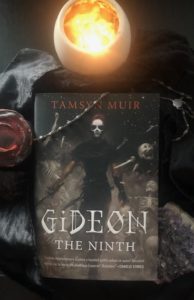e.e. cummings exhorted his readers to “dive for dreams or a slogan may topple you,” and I have tried to keep that warning in mind since I read it long ago. But today I have failed. A slogan has brought me down.
“Lesbian necromancers in space” is that slogan. I have toppled. I have fallen hard for Tamsyn Muir’s Gideon the Ninth.

She’s a girl worth falling for, that’s for sure. Gideon is as badass as they come, a swordfighting juggernaut with a fondness for dirty magazines and an undying devotion to being as rude as possible. Running her mouth has gotten her nothing but trouble—but what else is there to do in the sepulcher of the Ninth House? She hates the endless, dreary rituals and the congregation that’s more skeleton than alive. She hates the charade of opulence when the Ninth House is clearly teetering on the edge of ruin. And her dearest enemy, Harrow, is always around to ruin what fun she wring out of the place.
Harrowhawk Nonagesimus, Reverend Daughter and Heir to the Ninth, delights in tormenting Gideon, and her new plan is her worst yet: force Gideon to accompany her to the Lyctor trials and act as her cavalier, defending and obeying her at all times. But this time, there’s a catch. Harrow is sworn release Gideon once the trials are done. She’ll even pay her way.
So Gideon takes a gamble. After all, how bad could the Lyctor trials be? It’s just Harrowhawk and seven other necromancers competing to be the creepiest, most death-obsessed nerds in the whole interstellar empire. What could possibly go wrong?
Well…
For starters, the trials are not just for the necromancers. The cavaliers must participate as well, which Gideon dislikes intensely. She doesn’t like doing things, period, and she especially doesn’t like doing things that have a high likelihood of getting her super duper killed. And the trials are just the most straightforward way to die! The other Houses have the usual assortment of political and personal grudges, and may not be above murdering each other. Oh, and there might be a monster on the loose, some hideous amalgam of ghosts and bones and viscera that wants all the Houses to die horribly. Fuuuuun.
A note on the language, which has clearly seeped into this review: Muir’s style makes clear that she has spent a great deal of time on Twitter—which, by the way, is not a criticism (if it were, it would be a self-burn, since clearly I also must spend a lot of time on Twitter). It’s just a statement of fact. If you like that, be prepared for more of it, and if you’re turned off by colloquial flippancies—I don’t know, be sad?
The action, the dialogue, and the sexiness are all modern, but the setting is pure gothic antique. Oh, there are spaceships and scanners, but they’re remarkably well integrated into the cavernous, cadaverous First House. The basement is arranged like a Legend of Zelda dungeon, with a central chamber branching into sub-chambers that contain monsters and puzzles, and that yield keys to successful adventurers. The Lyctor trials require a thorough examination of every dusty crevice and moldering tapestry, and of course, every other necromancer and cavalier sneaking through them.

Though it’s couched as a competition, and many of the Heads of Houses treat it as such, it actually isn’t one. This is a nice touch, since I’m pretty sick of the reality show trope. Theoretically, everyone who arrives at First House can become a Lyctor. But that doesn’t downgrade even one iota of the tension, since the tension doesn’t arise from the setup. The tension comes from the personalities assembled, a much more impressive feat. It has a bit of a Game of Thrones feel, if Game of Thrones were set in a decrepit palace populated by ten times more animated skeletons than living people.
The politics make a nice balance with the action sequences, which are frequent and exciting. Remember how hot Sarah Connor was in Terminator 2 when she was doing pull-ups in the psych ward, and then fought her way out? It’s that, but as a book. There are murderous constructs (albeit of bone, not machinery). There is scientific research with deadly consequences. There is even—maybe—the end of the world.
I am intentionally comparing Gideon the Ninth to non-Gothic works, even though the overall aesthetic is gloomy, elaborate, and fixated on death. I have a real soft spot for the Gothic, but this book is so much more than just that. There’s a scene in a pool—you’ll know it when you get to it—in which two characters finally have a heart-to-heart. They also happen to be in a haunted building, surrounded by skeletons. It’s devastatingly beautiful, and it gets at what I think modern gothic lit can and should be. Tragic need not mean miserable. Morbid need not mean grimdark. And there’s no reason to pretend everyone is stuck in Victorian England when there’s a whole universe of possibilities. The atmosphere serves the story, and not the other way around.
I’m so glad the modern vernacular has a phrase that can encompass this book. (A slogan, if you will.) That phrase is “I’m dead.” Readers, I’m dead. This book slayed me. You should get slayed, too. We should all be dead over Gideon the Ninth.
